new posts in all blogs
Viewing: Blog Posts Tagged with: Sweden, Most Recent at Top [Help]
Results 1 - 25 of 47
How to use this Page
You are viewing the most recent posts tagged with the words: Sweden in the JacketFlap blog reader. What is a tag? Think of a tag as a keyword or category label. Tags can both help you find posts on JacketFlap.com as well as provide an easy way for you to "remember" and classify posts for later recall. Try adding a tag yourself by clicking "Add a tag" below a post's header. Scroll down through the list of Recent Posts in the left column and click on a post title that sounds interesting. You can view all posts from a specific blog by clicking the Blog name in the right column, or you can click a 'More Posts from this Blog' link in any individual post.

By: Lizzie Furey,
on 10/19/2016
Blog:
OUPblog
(
Login to Add to MyJacketFlap)
JacketFlap tags:
*Featured,
Books,
Geography,
Brazil,
atlas,
Sweden,
Place of the Year,
rio,
Atlas of the World,
The White House,
Aleppo,
Quizzes & Polls,
Election 2016,
brexit,
The UK,
Tristan da Cunha,
Add a tag
Quite a lot has happened in 2016. The year has flew by with history making events such as the Brexit, the Presidential election in the United States, and the blockade of Aleppo to name a few.
The post Place of the Year 2016 longlist: vote for your pick appeared first on OUPblog.
 Findus goes Fishing by Sven Nordqvist, translated by Nathan Large is a book for anyone who’s ever got out of bed the wrong side and felt like nothing at all could improve their day, and also for all those who’ve spent time with someone they love who’s under a dark cloud. It’s a story of patience, love, empathy and one crazy cat.
Findus goes Fishing by Sven Nordqvist, translated by Nathan Large is a book for anyone who’s ever got out of bed the wrong side and felt like nothing at all could improve their day, and also for all those who’ve spent time with someone they love who’s under a dark cloud. It’s a story of patience, love, empathy and one crazy cat.
It’s a gloomy autumn day and old farmer Pettson is down in the dumps. He doesn’t feel like doing any of the jobs he knows he needs to do. He’s blue and stuck in a funk. But his loyal and very dear friend, a kittenish cat called Findus is full of beans and just wants to play. Pettson is having none of it and snaps. “I AM IN A BAD MOOD AND I WANT TO BE LEFT ALONE!”
How can you bring a little happiness back to someone who is feeling unhappy and depressed? What can you do to bring them a small ray of sunshine when all they have above their heads is a dark cloud? Findus may want to have some fun, but he also really wants to make his good friend feel better and so with a little bit of patience, a lot of thoughtfulness and – because Findus is a bit of a rascal – a dash of mischief, Findus cleverly finds a way to help Pettson back on to his feet.
It’s not sugar coated. It’s not all sweetness and light. There is grunting and gloom aplenty. But there’s also a cat with a very big heart who’s not afraid of persevering even when he’s told to scram. Findus helps us all to find a bit of loyalty and kindness in the face of rejection.
This hugely reassuring story is a relatively quiet affair (certainly by the madcap standards of earlier Findus and Pettson escapades), with muted illustrations in browns and greys perfectly matching the moody atmosphere. But Findus goes Fishing is far from downbeat. There are still many moments to spark giggles (all I’ll say is: Who hasn’t known a child who loves to rock chairs onto their back legs?), and the detailed, rich illustrations are a full of cameos worthy of a spotlight on their own.

An excerpt from Findus Goes Fishing written and illustrated by Sven Nordqvist, translated by Nathan Large
I’m a strong contender for the the UK’s No. 1 Findus and Pettson fan, such is my love for these characters and the stories Sven Nordqvist writes. Findus goes Fishing is yet another wonderfully enjoyable, funny-yet-not-afraid-of-being-serious story really all about that most important of things: love and how we share it.
To celebrate the publication next week of Findus goes Fishing I interviewed the book’s UK English translator, Nathan Large and started by asking him a little about his background and how he became a translator. “I come from Gloucestershire and live in Stockholm, the home town of my partner, Emilie. I started translating while working as a linguist on a project developing machine translation tools. At first this was for research reasons, to explore patterns that our software could use. But gradually the translating branched out and found a life of its own.”
Having briefly worked as a translator myself many years ago I wondered what Nathan found particularly enjoyable about the work and his reply really resonated with me. “If you love language for its own sake, there’s always something to discover or enjoy in the work. If you are a curious person, translation also gives you the excuse to read about all sorts of subjects, making you among other things (un)popular at pub quizzes. Generally speaking, it is no bad thing to help people share their stories across languages.” I couldn’t agree more and this is certainly one of the reason’s I’m so grateful to translators, and publishing houses who seek out books in translation.
So how do the nuts and bolts of translation fit together for Nathan? Where does he begin? “It depends. Sven Nordqvist’s stories are pure fun. I read the book, then translate it the old-fashioned way, page by page. I check the draft against the original to see if I’ve missed anything, then put the Swedish to one side and focus on the English. Reading aloud is the best way to do this — the tongue trips over what the eye ignores.” This idea of reading aloud is really interesting – I’ve heard many authors use exactly the same technique, especially with picture book texts, and perhaps this shared approach is no surprise, as translators really are authors in disguise; translators, particularly literary translators, have to be great writers in their own language before sensitivity to a second language can come in to it.
Looking at the Findus and Pettson stories in particular, I love how they are universal – about deep friendship and kindness – but without losing their particular Swedish identity. What is it, however, that Nathan enjoys about these stories? “I like the interplay between words and images, but most of all I like the friendship between the two characters. This comes out particularly well in the latest book, which of course isn’t really about fishing at all but about Findus trying to get Pettson out from under his cloud.
Hawthorn Press wants to stay close to Nordqvist’s voice and the Swedish setting is largely left intact, lutefisk and all. However, observant readers may notice that Pettson and Findus drink tea in one of the books, I won’t say which one. Naturally it should have been coffee.
” At this point I rush off to gather all my Findus and Pettson stories to track down the missing coffee… It’s amazing how big a smile this puts on my face.
So occasionally there might be textual changes, and this leads me to wondering about changes made in the illustrations. At the moment I’m working with a colleague on a close comparison of a French book, which has been translated quite differently into US and UK Englishes. That different words are chosen (in essentially the same language) is interesting, but what has really startled us is that some of the illustrations have been significantly altered. I’m delighted to hear that this doesn’t happen with with Findus and Pettson stories, other than occasionally translating text that appears as part of a picture.

An excerpt from Findus Goes Fishing written and illustrated by Sven Nordqvist, translated by Nathan Large
Our experience with the French book makes me curious about other translations of the Findus and Pettson stories. Hawthorn Press (the UK publishers of Findus and Pettson) has a policy of letting the Swedish character shine threw their texts, but this isn’t the case with all versions of these stories. “It can be interesting to see what other people do with the same source material. The older US versions take quite a different approach, changing all the names and omitting much of the text. Hawthorn’s editions of Findus and the Fox and Pancakes for Findus are actually slightly edited Gecko translations, so there’s some continuity there.”
Ah! Changing names! This is a pet-hate of mine in translated stories, even if in theory I can understand the rationale that sometimes lies behind it (I can see why lovely – but typographically terrifying looking – Nijntje became Miffy for example) but why Findus and Pettson were renamed Mercury and Festus in the US I’d love to know. As to cutting the text, shortening the story, I wonder if this has something to do with different cultural expectations about illustrated books. Those who know different markets would probably agree with Charlotte Berry from the University of Edinburgh that “picture books on the continent tend to be aimed at older children than is generally accepted in the UK and the US and often contain a much higher proportion of text to image” and certainly Findus and Pettson do stand out here in the UK for looking like picture books in size and richness of illustration, but having the length of text at least sometimes associated with fiction for younger readers.
 The idea about helping people share their stories across languages and cultures is still swirling in my head, so I can’t resist asking Nathan about Swedish children’s books which haven’t yet been translated into English but which he thinks would bring joy and delight to new readers. “Barbro Lindgren’s books about Loranga, Masarin och Dartanjang: a young boy, his gleefully irresponsible father and a grandfather who lives in the woodshed. First published in 1969-70, the stories are based — give or take the occasional bed-eating giraffe — on Lindgren’s own experiences raising her young family. They are quite unlike anything I have read before. English readers might recognize in Loranga the very opposite of the helicopter parent. With their surreal humour, the books are perfect for reading aloud — to children and grown-ups alike.”
The idea about helping people share their stories across languages and cultures is still swirling in my head, so I can’t resist asking Nathan about Swedish children’s books which haven’t yet been translated into English but which he thinks would bring joy and delight to new readers. “Barbro Lindgren’s books about Loranga, Masarin och Dartanjang: a young boy, his gleefully irresponsible father and a grandfather who lives in the woodshed. First published in 1969-70, the stories are based — give or take the occasional bed-eating giraffe — on Lindgren’s own experiences raising her young family. They are quite unlike anything I have read before. English readers might recognize in Loranga the very opposite of the helicopter parent. With their surreal humour, the books are perfect for reading aloud — to children and grown-ups alike.”
I love the sound of these stories… let’s hope a publisher is listening and gives Nathan a call!
My thanks go to Nathan for giving us an insight into how he works, and most especially for bringing us Sven Nordqvist’s brilliant, delightful, heartwarming big hugs which look like books, filled with Findus and Pettson stories. All power to translators and the publishing houses who support them!

If you’d like to find out about other Findus and Pettson stories here are all my reviews:
Pancakes for Findus and When Findus was Little and Disappeared
Findus and the fox
Findus at Christmas
Findus Moves Out
Findus Plants Meatballs
Findus, Food and Fun – Seasonal crafts and nature activities

By: Amelia Carruthers,
on 2/5/2016
Blog:
OUPblog
(
Login to Add to MyJacketFlap)
JacketFlap tags:
Science & Medicine,
Health & Medicine,
dialysis,
Kidney disease,
medical history,
Books,
Crafoord Foundation,
David Goldsmith,
Dialysis Machine,
Fourth Edition,
Gambro,
Nils Alwall,
Oxford Textbook of Clinical Nephrology,
Willem Kolff,
WWII,
Technology,
hospital,
machine,
Sweden,
surgery,
discovery,
World War Two,
*Featured,
Add a tag
During the night, between 3rd and 4th September 1946, things were stirring in the basement of the internal medicine department, at the university hospital of Lund, Southern Sweden. A 47-year-old man had been admitted for treatment. His main problem was uraemia (urea in the blood), but he was also suffering from silicosis (a lung disorder), complicated by pneumonia.
The post Nils Alwall: The quiet, unassuming Swede appeared first on OUPblog.
.jpeg?picon=3306)
By: Zoe,
on 4/20/2015
Blog:
Playing by the book
(
Login to Add to MyJacketFlap)
JacketFlap tags:
Humour,
Families,
Dads,
Sweden,
Eva Eriksson,
Books in translation,
Night-time,
Moon / stars,
Ulf Stark,
Add a tag
Sharing something beautiful which means a great deal to you can be an awkward, even embarrassing thing to do. It can feel like going out on a limb. You take the risk of appearing sentimental and perhaps even slightly loopy.
Quite why this should be the case, I don’t know. After all, in trying to offer a special moment or experience, all the giver wants is for you to feel something of the same joy, calm, delight and warmth. But it’s a vulnerable moment, full of potential for dreams to be trampled on.
As a parent I’ve sometimes found myself in the situation where, just for a moment  , I want my kids to take me seriously , to meet me as a friend and to fall in love with what I’ve fallen in love with. Don’t get me wrong, of course I want them to have their own opinions and discover their own places and times of magic. But I also want to gift them moments of golden glow inside them, serve up nuggets of warmth that will stay with them always, through bad times and good when remembering times and places that are somehow beautiful.
, I want my kids to take me seriously , to meet me as a friend and to fall in love with what I’ve fallen in love with. Don’t get me wrong, of course I want them to have their own opinions and discover their own places and times of magic. But I also want to gift them moments of golden glow inside them, serve up nuggets of warmth that will stay with them always, through bad times and good when remembering times and places that are somehow beautiful.
It happens a lot with books of course – I’ll start books I loved as a child with bated breath: What will the kids make of them? Sometimes it happens with music, and also locations with views or spaces that take my breath away or inspire excitement or awe.
 And so when I opened When Dad Showed Me the Universe written by Ulf Stark, illustrated by Eva Eriksson and translated by Julia Marshall I knew the story would speak to me.
And so when I opened When Dad Showed Me the Universe written by Ulf Stark, illustrated by Eva Eriksson and translated by Julia Marshall I knew the story would speak to me.
A father decides that his child is old enough to be shown the universe, and takes him on a night-time walk through the town and out into an open space far from street lights where they can watch the stars together and marvel in the sparkle and space and silence. But what does the child make of all this?
The bright intensity of beauty is made bearable with bucket loads of dead pan humour. An extra pair of socks is needed because – it turns out – the universe is pretty cold (‘“Minus 263 degrees,” Dad said‘). The universe turns out to be fairly easy to find; with echoes of Neverland “the way there was straight ahead and then to the left.” And when they finally arrive at the destination picked out by Dad, “I had a feeling I’d been here before, that this was the place where people walked their dogs.”
Indeed, there is a final twist to the story which brings everyone back from interstellar dreams to everyday reality with quite a bump, brilliantly adding a layer of laughter to a moment of intimacy and affection; Father and child do get to create a special shared memory that will stay with them all their lives, but it may not be quite that which the Dad had anticipated!


Pitch-perfect words deserve exceptional illustrations, and Eva Eriksson’s soft and dreamy pencil work only enriches Stark’s text. Muted tones predominate, with the exception of an intense blue for the night time sky, giving those spreads extra impact. The story is told as a first person narrative – the child retelling the entire experience, and the illustrations also emphasise the child’s view of the world; (s)he is often looking in a different direction to his/her father, picking up on other things of interest, whether that’s the liquorice on sale in the shop or the abandoned trike in the park, I couldn’t help smiling broadly at the different facial expressions in father and child when first they gaze at the vastness of the stars above them.
[I think it is worth noting that although some may assume the child is a boy, the text does not assert this. Indeed, given the first person narrative, there’s no need for gendered pronouns when referring to the child, who could in fact be a girl. This possibility is one of the great things about this story and translation.]

When Dad Showed Me the Universe is a very clever, moving and extremely funny book about parental love. In fact, in sharing it with you here on the blog, I feel a little like the father in this beautiful book. I so want you too to gasp in delight, smile brightly and feel that sense of magic settling on you when you read this. I can’t give you starlight, but I can wholeheartedly recommend you find a copy of When Dad Showed Me the Universe without delay.
*************
The hilarity in When Dad Showed Me the Universe has ensured that it is a book my kids have wanted to share multiple times. But already after the first reading they could see my thinking: Were they going to get to see the universe too?
First I prepared…

A perfect universe-gazing pack
A tarpaulin (to put on the ground in case it is damp)
A camping mat for each person
A sleeping bag for each person
A red torch – we used a back bike light, but you could use a normal torch with red acetate taped over or held in place using an elastic band. By using red light, your eyes will adjust more quickly to the darkness.
Hot water bottles and hats for extra cosiness
This pack was left in the garden shed whilst I kept an eye on the weather forecast for a few days, looking out for a clear night. When one came along, I was all ready to go into slightly crazy mode and tell my kids that even though they had their pyjamas on, we were going into the garden in the dark.
I didn’t take many photos as the idea was to disconnect from all the buzz we normally have going on in our lives, and just to relax watching the stars twinkling.

We were super snug and spent about 40 minutes just gazing, sometimes chatting, sometimes just being quiet.

I’m no good at night-time photography (see above). What we saw wasn’t quite like this…

Photo: Scott Wylie on Fiickr Creative Commons
…but we did all feel a sense of awe and peace in a way that took me by surprise.
We didn’t listen to any music whilst we were outside, but here is a marvellously celestial playlist:
When I Look Into the Night Sky by Lori Henriques
How Big by Eric Herman
When You Wish Upon a Star from Disney’s Pinocchio
Starlight, Starbrighy by LuLu and the TomCat
You might also like to take a look at this informative list of music (both classical and pop) inspired by astronomy, written by Andrew Franknoi.
Other activities which could go well with reading When Dad Showed Me the Universe include:
The whole variety of ideas included in the official Teaching Notes for this book, created by Gecko Press.
Watching a meteor shower. Here’s a great video on The Kid Should See This on how, where and when to do exactly this.
Asking your friends and neighbours for their tips on the most beautiful place they know nearby, and then committing to visiting it. Maybe you’ll discover new places and make new memories. I found even just asking myself (and the kids) what’s the most beautiful place near where I live got us thinking hard and engaged in quite lively and at times suprising conversation.
What’s your happiest memory from going somewhere special with a parent or a child?
Disclosure: I received a free review copy of this book from the publisher.
.jpeg?picon=3306)
By: Zoe,
on 12/2/2014
Blog:
Playing by the book
(
Login to Add to MyJacketFlap)
JacketFlap tags:
Mending/recycling,
Sven Nordqvist,
Eva-Lena Larsson,
Kennert Danielsson,
Nathan Large,
Nonfiction,
Sweden,
Beads,
Books in translation,
Calendars,
Exploration,
Nature play,
Add a tag
Although there’s something of a holiday / celebration at the end of this month to enjoy first (!), I’m already thinking about next year, planning projects, drawing dreams and envisaging adventures, not least of all here on Playing by the book (do let me know if there’s something you’d particularly love to see here in 2015).
 This forward and full-of-hope looking at the future, with plans for play and learning, is also found in the latest offering (in English) for fans of two of my very favourite book characters: Findus, Food and Fun – Seasonal crafts and nature activities is a calendar of craftiness from my long term Swedish sweethearts, Findus and Pettson, or rather from their creator, Sven Nordqvist, assisted by Eva-Lena Larsson, Kennert Daniels and translator Nathan Large.
This forward and full-of-hope looking at the future, with plans for play and learning, is also found in the latest offering (in English) for fans of two of my very favourite book characters: Findus, Food and Fun – Seasonal crafts and nature activities is a calendar of craftiness from my long term Swedish sweethearts, Findus and Pettson, or rather from their creator, Sven Nordqvist, assisted by Eva-Lena Larsson, Kennert Daniels and translator Nathan Large.
Findus is a cheeky, cheerful cat on the ramshackle farm owned by grumpy but loveable Pettson. Stories of their life together are full of mishaps, mysterious little creatures called muckles, kindness and compassion. The illustrations are scrumptious, drawn with delicious humour and attention to detail. I don’t think there is another series of books which I’ve dedicated so much time to on Playing by the book. Perhaps that alone tells you how wonderful I think these books are and how much I want to press them into the palms of everyone and anyone who stumbles upon my blog.
This latest book isn’t a story book, but rather a compilation of crafts and activities very much in the spirit of Findus and Pettson, with lots of outdoor exploration, tinkering, making, pottering, discovering and being resourceful. The crafts are themed by calendar month and richly illustrated with Findus, Pettson, chickens and muckles getting involved and trying out the projects at hand. The choice of crafts is wide ranging and includes the unusual; from propagating succulents, to using ants to dye bluebells, to making your own weather station to weaving a rug, there’s a mixture play and exploration driven by interacting with the natural world and/or being inspired by the farmstead on which Findus and Pettson live.

An interior detail from Findus, Food and Fun.
I suspect many readers will come to this wonderful book because they are already solid fans of Nordqvist’s lovely world where problems are solved with kindness. cooperation and respect. However, if you’ve not met Findus and Pettson before there’s still an enormous amount to enjoy in this book; the crafts are quirky, sometimes a little bit crazy, and ideal for anyone who wants to encourage natural play and exploration.
The first project my girls chose to try was making necklaces out of dried beans; first you have to soak them overnight and then you can thread them onto thread (as the book advises, dental floss is good because it is extra smooth and slidey). One packet of mixed dried beans meant for soup were sorted into bowls and left to soak:

Next morning the girls were intrigued to see how the beans had changed, and were soon up and running with threading them into necklaces.

Compare this with the photo above!
With lots of opportunities for learning about science, plant life and even maths (via patterns on the necklaces), this project – like so many in the book – could be used for more structured learning, as well being simply an enjoyable experience. These lovely chains of beads could be used as alternative Christmas decorations too – perhaps alongside popcorn strings.

Whilst making our necklaces we listened to:
Black Bean Soup by David Soul
Beans In My Ears by Serendipity Singers
Oats and Beans and Barley – there are loads of versions, but I like this one for its melodeon
Findus, Food and Fun: Seasonal crafts and nature activities is so packed with activities I won’t suggest any more here, other than to also point you to another craft book from the same publisher, Making Woodland Crafts by Patrick Harrison, a trainer of Forest School leaders. Many of the activities in this book are ones I can imagine Findus, Pettson and kids and families who love the outdoors relishing.
What nature crafts have you enjoyed recently? When did you last take a book outdoors to read under (or up) a tree?
Don’t forget to leave me a comment if you’ve any ideas / suggestions about how you’d like Playing by the book to develop in 2015 
Disclosure: I received a free review copy of Findus, Food and Fun: Seasonal crafts and nature activities from the publisher.

By:
Hannah,
on 9/30/2014
Blog:
The Open Book
(
Login to Add to MyJacketFlap)
JacketFlap tags:
gender,
sweden,
gender roles,
gender stereotypes,
Educator Resources,
Diversity, Race, and Representation,
Guest Blogger Post,
Diversity 102,
picture books around the world,
Add a tag
 Back in June, Laura Reiko Simeon wrote about how race is handled in Swedish picture books. We’re thrilled to host Laura again as she sheds light on how Swedish picture books handle gender and gender-ambiguous characters.
Back in June, Laura Reiko Simeon wrote about how race is handled in Swedish picture books. We’re thrilled to host Laura again as she sheds light on how Swedish picture books handle gender and gender-ambiguous characters.
You sit down with your favorite 4-year-old to read a sweet, wordless picture book featuring a little duck swimming down the river. Quickly, without thinking too hard, what pronoun do you use to describe the duck? Do you say, “Look at him paddle past that shaggy dog!” or “What does she see in the sky?”
If you were like the mothers in a 1985 study, you would use masculine pronouns for 95% of animal characters with no gender-specific characteristics. A follow-up study from 1995 examined children’s use of pronouns and found that by age 7 they had absorbed and were repeating these same gender stereotypes. Listen to those around you: has it changed much since then?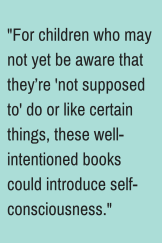
In the US, Sweden is widely regarded as a leader in gender equality, although many Swedes still see a need for greater progress. Meanwhile, our own biases are apparent, for example when we consider gendered toys. Compare this 1981 Lego ad, with its blue jeans and t-shirt-clad girl to the pink-infused products targeted at girls today. As with other social issues, picture books reflect concerns in society at large – but how they’ve done so is dramatically different in the US as compared to Sweden.
Some American picture books encourage acceptance of kids who break free from gender restrictions: Charlotte Zolotow’s William’s Doll, Cheryl Kilodavis’s My Princess Boy, and Campbell Geeslin’s Elena’s Serenade, among others. The point of these stories is that a character is acting in opposition to gender norms, but for children who may not yet be aware that they’re “not supposed to” do or like certain things, these well-intentioned books could introduce self-consciousness.
What have largely been missing from English-language picture books are deliberately gender-ambiguous characters that are neither being bullied nor defiant. They just are. Rather than focusing on the consequences (good or bad) of pushing against societal restrictions or elevating the rebel as cultural hero, they turn the focus on the reader. Do we feel uncomfortable if we don’t know someone’s gender? Why? Do we make assumptions about gender based on what someone is doing or wearing? Why?
We do have some characters – e.g. the diverse, roly-poly infants in Helen Oxenbury’s delightful baby books – that are non-gender specific, but they tend to be in simple, relatively plot-free books for the very young. They are distinct from the Swedish picture books in which pronouns are cleverly avoided and characters send deliberately contradictory gender signals. My earlier post about
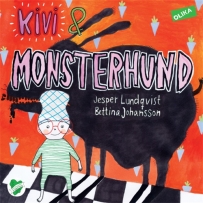
Kivi and the Monster Dog
Swedish approaches to ethnic diversity introduced the concept of not making difference the problem. There is a similar philosophy at work here.
The Swedish Institute for Children’s Books publishes annual “Book Tastings” that identify trends for the year’s publications. The theme for 2012 was “Borders and Border Crossings,” and one border was gender: not just sexual orientation or gender roles, but the concept of gender as an identifier itself.
The anti-bias publisher OLIKA has published several titles of this nature, but the one that made the biggest splash was Kivi and the Monster Dog by Jesper Lundqvist, the first children’s book to use the gender-neutral pronoun, “hen.” (In Swedish, “hon” means “she” and “han” means “he.” First proposed in the 1960s, “hen” was mostly used in academic research and hipster neighborhoods of Stockholm.) In this funny rhyming story, a small person, Kivi, wishes for a pet dog and ends up instead with a demanding beast that runs amok.
Åsa Mendel-Hartvig and Caroline Röstlund write about Tessla, a preschooler clad in gender-neutral clothes and boasting a mop of brown hair. In Tessla’s Mama Doesn’t Want To! and Tessla’s Papa Doesn’t Want To!, the child, in an amusing role reversal, creatively cajoles badly behaving parents into leaving the park, washing their hair, waking up on time or going to work.
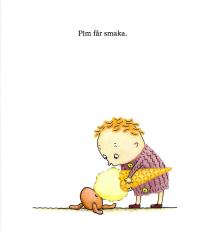
interior page from Pom and Pim
Pom and Pim by Olof and Lena Landström may be the only Swedish gender-neutral book that has been translated into English. The first in a series, it features an adventurous toddler, Pom, who sends mixed gender signals: a boyish-sounding nickname, sparse curls, a long purple sweater, and a little pink toy (Pim). The story is told without pronouns, yet two professional American reviewers assumed Pom was male and referred to the character as “he.”
In Maria Nilsson Thore’s Bus and Frö Each on Their Own Island, two gender-ambiguous animals reach out from their lonely islands to become friends. One is shown variously smoking a pipe and knitting. In Jonatan Brännström’s The Lightning Swallower, we never learn the gender of the narrator, who is terrified of thunderstorms.
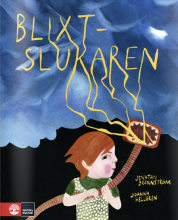
The Lightning Swallower
These books make a reader consider what markers are “masculine” or “feminine” – and why. They don’t dictate what you “should” do – rebel or conform – or offer value judgments about those who do either. In English-language books, feisty heroines reject traditionally female pursuits as “boring” (what about those girls who do love sewing and cooking?) and boys are persecuted for their love of pink and dolls (making these preferences seem risky to express). With their gender-ambiguous characters, Swedes have tilted the lens slightly and given us a whole new perspective through which to consider this topic. Can we change the terms of the discussion instead of framing everything in terms of binary gender categories? Where could that small but crucial shift take us?
 The daughter of an anthropologist, Laura Reiko Simeon’s passion for diversity-related topics stems from her childhood spent living all over the US and the world. She fell in love with Sweden thanks to the Swedish roommate she met in Wales while attending one of the United World Colleges, international high schools dedicated to promoting cross-cultural understanding. Laura has an MA in History from the University of British Columbia, and a Master of Library and Information Science from the University of Washington. She lives near Seattle.
The daughter of an anthropologist, Laura Reiko Simeon’s passion for diversity-related topics stems from her childhood spent living all over the US and the world. She fell in love with Sweden thanks to the Swedish roommate she met in Wales while attending one of the United World Colleges, international high schools dedicated to promoting cross-cultural understanding. Laura has an MA in History from the University of British Columbia, and a Master of Library and Information Science from the University of Washington. She lives near Seattle.
Filed under:
Diversity 102,
Diversity, Race, and Representation,
Educator Resources,
Guest Blogger Post Tagged:
gender,
gender roles,
gender stereotypes,
picture books around the world,
sweden 

Today we look at the work of Olle Forsslöf, Cartoon Brew's Artist of the Day!
 The daughter of an anthropologist, Laura Reiko Simeon’s passion for diversity-related topics stems from her childhood spent living all over
The daughter of an anthropologist, Laura Reiko Simeon’s passion for diversity-related topics stems from her childhood spent living all over  the US and the world. She fell in love with Sweden thanks to the Swedish roommate she met in Wales while attending one of the United World Colleges, international high schools dedicated to promoting cross-cultural understanding. Laura has an MA in History from the University of British Columbia, and a Master of Library and Information Science from the University of Washington. She lives near Seattle.
the US and the world. She fell in love with Sweden thanks to the Swedish roommate she met in Wales while attending one of the United World Colleges, international high schools dedicated to promoting cross-cultural understanding. Laura has an MA in History from the University of British Columbia, and a Master of Library and Information Science from the University of Washington. She lives near Seattle.
As the Librarian and Diversity Coordinator at a school with a global population, my guiding vision is that the books I offer must be both mirrors that reflect children’s lives and windows that open up new worlds. This is a challenge when the small percentage of children’s books in English showing people of color is largely restricted to stories of oppression far removed from my students’ daily lives of homework, soccer, and wishing for a puppy. Of 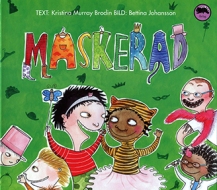 course it’s important to be aware of injustice, but it sends a powerful message if we only show racial diversity in settings of suffering and conflict.
course it’s important to be aware of injustice, but it sends a powerful message if we only show racial diversity in settings of suffering and conflict.
While “diversity” is not generally the first word that comes to mind when Americans think of Sweden, today fully 20% of Swedes are either immigrants or children of immigrants, many from Africa, Asia and the Middle East. Combine this with Swedes’ commitment to children’s rights and a vibrant literary and artistic community, and you have the perfect setting for stimulating debates and boundary-pushing creativity.
A grant from the Swedish Institute allowed me to visit Stockholm last year to interview librarians, authors, illustrators, publishers, and teachers about how recent picture books reflect their multicultural society. During my visit I learned about a fundamental distinction between their approach to diversity and our own. There is a concerted effort to publish works of artistic and literary merit, free from heavy moralizing, that express a child’s perspective and tear down the walls that segregate people of color into a few categories: civil rights hero, the downtrodden, and token exotic friend.
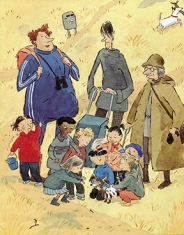
from Bridget and the Gray Wolves by Pija Lindenbaum
There is a firm belief in Sweden that the problem in stories must be about something other than differences.Marie Tomicic, of the Swedish multicultural publisher OLIKA, explained that when the problem in the story is the fact that a boy is playing with a doll, that sends a very different message from a book where the boy’s choice of a doll is unremarkable and the conflict “emerges from the play itself,” such as arguing about what scenario to act out.
This is why recent Swedish picture books that show ethnic diversity involve conflicts about ordinary, universal topics such as sharing. Several authors who are passionate about diversity proudly told me that if you were to read the text alone, you would never know that the illustrations in their books showed characters of many races. Often it’s even hard to tell exactly what ethnicity characters are meant to be. The Swedish Institute for Children’s Books monitors and publishes detailed data about gender – but not race – largely because of this ambiguity.
Gunna Grähs, a prolific author and illustrator, writes about a multicultural Swedish suburb where immigrants from several continents pursue ordinary daily activities such as buying lottery tickets or helping a neighbor who forgot to feed his cat. For decades Siv Widerberg has written stories in which multiethnic groups of children build sandcastles at daycare, collect sticks in the woods, and more. Anna Bengtsson shows characters with different ethnic backgrounds going to the hairdresser or playing in a pile of snow. Similarly, Eva Lindström, Lena Anderson, Eva Susso, Pija Lindenbaum, and many other Swedish writers are revolutionizing children’s literature simply by bringing people of color out of the margins and into the mainstream of daily life.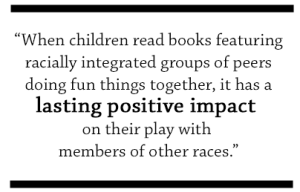
This is not to say that Swedes have arrived at a place of perfect enlightenment. Many of them admire our willingness to publish children’s books that explicitly talk about prejudice, since history and culture have made this topic uncomfortable in their own country.
Controversy erupted in Sweden 2012 over Little Heart, a character intended to reclaim and empower the pickaninny stereotype. There was also heated debate about whether hip hop artist and children’s culture advocate Behrang Miri was justified in moving Tintin in the Congo to the adult section of a library. In response to these painful incidents, Professor of Illustration Joanna Rubin Dranger has been working on improving Swedes’ visual literacy 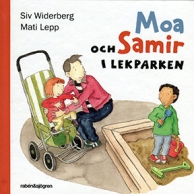 around racial stereotypes through her fascinating School of Images.
around racial stereotypes through her fascinating School of Images.
Yet recent research supports a significant benefit of the Swedish approach: when children read books featuring racially integrated groups of peers doing fun things together, it has a lasting positive impact on their play with members of other races. (This was not the case when they read diverse books showing members of just one race.) The bad news? There are so few of these types of books that likely “most American children have rarely or never seen a cross-race friendship depicted in a picture book.”
What can we do without access to most of these wonderful Swedish books? We can bring greater intentionality to how we choose diverse books. We can search for and purchase books that show diversity as a natural and positive aspect of daily life. We can discuss the implicit and explicit messages in diverse books with young readers, helping them learn to read with awareness. Children deserve more from their diverse books: let’s start tearing down those walls.
Filed under:
Diversity, Race, and Representation,
Guest Blogger Post Tagged:
cultural diversity,
diversity in publishing,
diversity issues,
sweden 

.jpg?picon=1452)
By: Elise N. Black,
on 6/7/2014
Blog:
Elise's Art Garden
(
Login to Add to MyJacketFlap)
JacketFlap tags:
Sweden,
missionary,
National Day,
The Church of Jesus Christ of Latter-day Saints,
Du fria,
Du gamla,
köttbullar,
Lingon sylt,
Sverige,
Add a tag
I left a bit of my heart in Sweden some years ago while serving as a missionary for
I still haven't been able to return, but hope to one day...
perhaps when the last of my wee ones is on his own.
Until then, I will have to content myself honoring her as I can, eating köttbullar
och Lingon sylt at IKEA,
singing "Du gamla, Du fria" June 6th
and creating images such as this one.
Jag älskar min vackra Sverige!
By: Grant Overstake,
on 7/26/2013
Blog:
(
Login to Add to MyJacketFlap)
JacketFlap tags:
Chile,
Uncategorized,
Canada,
Japan,
Taiwan,
Amazon,
Philippines,
Mexico,
France,
Australia,
India,
Poland,
Germany,
New Zealand,
Pakistan,
Puerto Rico,
Belgium,
Spain,
Slovenia,
United Kingdom,
Finland,
South Africa,
Brazil,
Singapore,
Nicaragua,
Ireland,
Netherlands,
Italy,
Turkey,
Israel,
Switzerland,
Nigeria,
Sweden,
Indonesia,
Mongolia,
Thailand,
Argentina,
Morocco,
Peru,
Jamaica,
Norway,
Egypt,
Indiebound,
Iceland,
Venezuela,
Bahamas,
Denmark,
Greece,
United States,
Portugal,
Czech Republic,
Colombia,
Romania,
Croatia,
Saudi Arabia,
Hong Kong,
Ukraine,
Jordan,
Yemen,
Algeria,
Hungary,
Bermuda,
Ecuador,
Bulgaria,
Estonia,
Tunisia,
Trinidad and Tobago,
Girls Sports,
Bahrain,
Lithuania,
Namibia,
United Arab Emirates,
Grant Overstake,
Inspirational Sports Stories,
Maggie Vaults Over the Moon,
young adult sports,
KSHSAA,
Pole Vault Fiction,
Track and Field Stories,
sports novels,
Recommended sports books for teens,
Watermark Books and Cafe,
Kansas State High School Activities Association Journal,
Austria Botswana,
Insirational Sports Books,
Isle of Man,
Republic of Korea,
Russian Federation,
Add a tag
Maggie Steele, the storybook heroine who vaults over the moon, has been attracting thousands of visitors from around the world. So many visitors, in fact, that she’s using a time zone map to keep track of them all.* People are … Continue reading →
By:
Eva-Lena Rehnmark,
on 2/15/2013
Blog:
Eva-Lena Rehnmark Illustration
(
Login to Add to MyJacketFlap)
JacketFlap tags:
children's books,
tradition,
bird,
dove,
sweden,
acrylic painting,
birch bark,
swedish,
folk costume,
Add a tag

A small acrylic painting inspired by Swedish traditional Folk Costumes… and forest doves.


In January, I was very pleased to learn that Louise Borden and her book
His Name Was Raoul Wallenberg had been named winner of the 2013 Sydney Taylor Book Award for Older Readers by the
Association of Jewish Libraries. The Sydney Taylor Book Awards are given annually to those outstanding works that authentically portray the Jewish experience.
Born into a relatively well-to-do family of bankers in Stockholm, Sweden in 1912, Raoul Wallenberg was always excited and curious about everything and his endeavors were encouraged and supported by his family. At age 11, he traveled alone from Sweden to Turkey on the Orient Express to visit his grandfather, Gustaf Wallenberg, Sweden's minister to Turkey. And at age 19, he left Sweden to attend college at the University of Michigan, majoring in Engineering. When he returned to Europe, Raoul spent time travelling and as he did, he began to hear stories from Jews who has escaped Hitler's Germany, stories about new laws, beatings and even murder inflicted on Jews by the Nazi government.
Raoul had taken a job and was an excellent salesman, helped by his ability to speak different languages. But pretty soon the world was at war. As he watched country after country fall to Nazi occupation, he worried about Sweden's neutrality. Denmark and Norway, close neighbor, had already fallen to the Nazis. When roundups and deportations were announced in Denmark in 1943, Sweden gave permission for Danish Jews to enter the country, saved by the many Danish fisherman willing to sail them there. Swedish freedom and neutrality remained intact.
Hungary was also a country with a large Jewish population, but it was not a neutral and in 1944, it, too, became a Nazi occupied country. Roundups and deportations of Hungarian Jews began and many went to the Swedish embassy seeking visas to Sweden. But the War Refugee Board in America wanted a neutral Swede to organize some relief for the Jews in Hungary. Raoul Wallenberg, with his many languages and skill as a salesman, was just the person they needed.
Wallenberg devised a legal looking Protection Pass or S
chutzpass that were like Swedish passports and protected the bearer from deportation. Wallenberg even created a single
Schutzpass that protected whole families. But the
Schutzpass, which probably saved around 20,000 people, was only one way Wallenberg worked to help Hungarian Jews.
Ironically, the man who worked tirelessly to save Jews, was picked up by the Soviet military in Hungary and on January 17, 1945, he was last seen being driven away in a Soviet car, and was never to be heard from again.
The details of Wallenberg's life and the work he did saving Jews in Hungary are all nicely detailed in-depth in Borden's free verse biography of this incredible man.
His Name Was Raoul Wallenberg is beautifully put together, divided into 15 sections, each one chronicling a period of Wallenberg's life with a wealth of supporting photographs and other documents that give a comprehensive picture of his life as he grows and changes and even goes beyond his disappearance up to the present. As you will discover when you read the Author's Note at the back, Borden had the privilege of working closely with his family over many years and so had much more personal insight into the real child and man that was Raoul Wallenberg than biographers are generally privy to. And that shows throughout the book.
But
His Name Was Raoul Wallenberg is more than just a biography, it is a shining example of one man who rose to the challenge at a very bleak time in history and who made a difference in the world, saving so many Hungarian Jews from certain death. Borden has written a book that is a fine addition to the whole body of Holocaust literature and anyone interested in the Jewish experience at that time.
Raoul Wallenberg was named Righteous Among The Nations by Yad Vashem in 1963 in Israel.
Come back tomorrow for an interview with Louise Borden.
This book is recommended for readers age 12+
This book was purchased for my personal library
You can find more information about Raoul Wallenberg at his
alma mater, the University of Michigan,
here
You can find more on Raoul Wallenberg and the plight of Hungarian Jews at the United States Holocaust Memorial Museum
here
Be sure to visit Louise Borden's website
here
This review also appears on my other blog
Randomly Reading
Nonfiction Monday is hosted this week by
Abby the Librarian
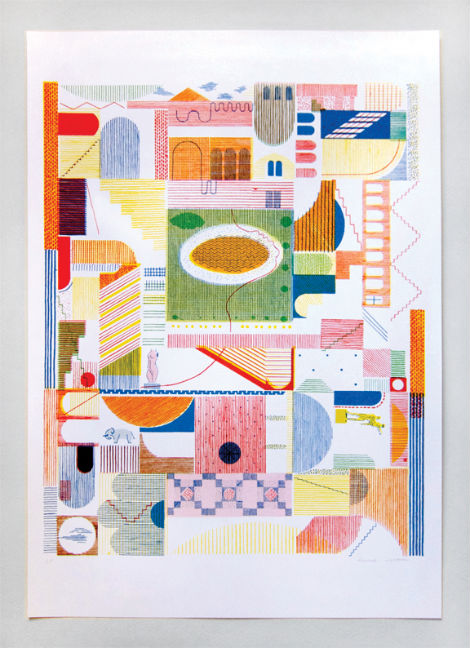
Hannah Waldron is an artist and designer that shuffles her time between Stockholm and London. Her work is clean, bright, and filled with geometric forms juxtaposed against loose lines, and varied patterns and textures. The print above is just a taste of her work, and was commissioned by the Victoria and Albert museum in London.
To see more of Hannah’s work, visit her site. Also be sure to pick up one of her beautifully designed Furoshiki (a type of traditional Japanese wrapping cloth that were frequently used to transport clothes, gifts, or other goods) through her Editions page and Link Collective.
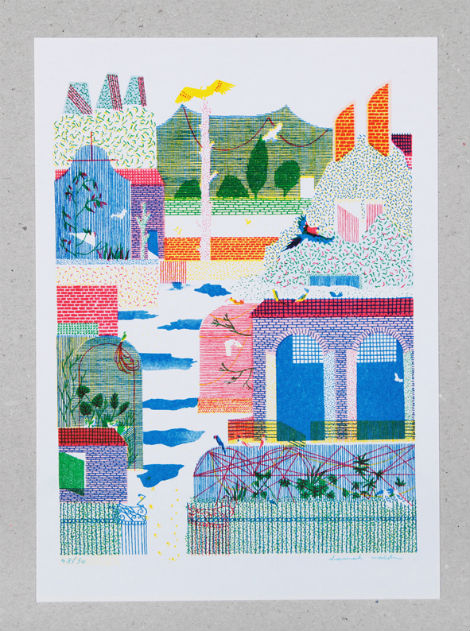



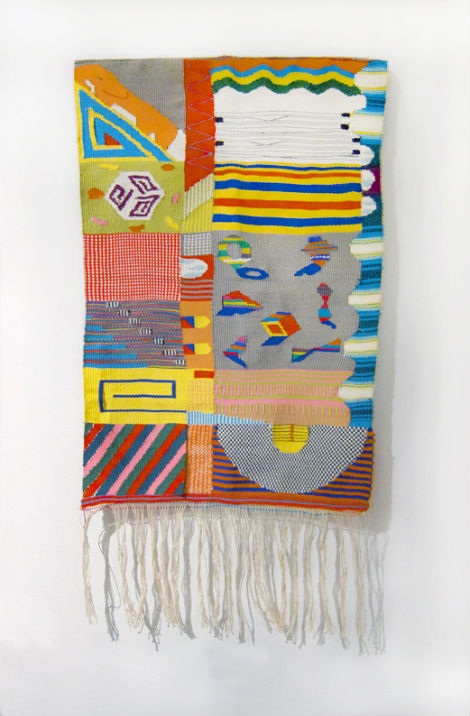
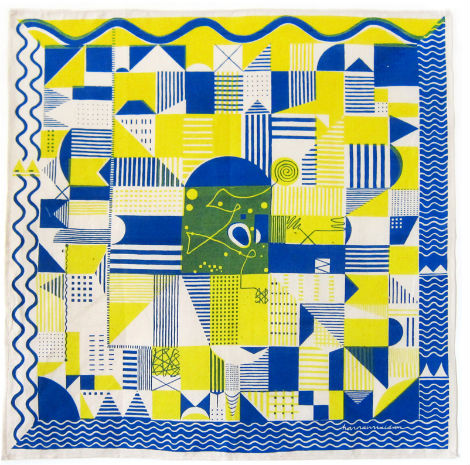
Share This
Featured Book:
Matte Stephens: Selected Works.
A Huge thanks to Squarespace for sponsoring this week’s RSS Feed!


By: Jerry Beck,
on 11/8/2012
Blog:
Cartoon Brew
(
Login to Add to MyJacketFlap)
JacketFlap tags:
Rickard Bengtsson,
Saigo No Shudan,
YungSung Song,
US,
Japan,
France,
South Korea,
Sweden,
Matt Reynolds,
Animated Fragments,
Joshua Catalano,
Add a tag
There is a mind-boggling breadth of expression and experimentation across the contemporary global animation scene. The short animation clips and exercises that I offer in Animated Fragments represent just a glimpse of the fresh ideas being explored by today’s animators:
“QQQ” Trailer by YungSung Song (South Korea/Japan)
“Feuerwerk” by Joshua Catalano (France)
“More Than A Feeling” by Matt Reynolds (US)
“CVTV” by Saigo No Shudan (Japan)
“Feminine Flow” by Rickard Bengtsson (Sweden): “This animation, except the subtle background texture, is created 100% in After Effects. All of the animation is created and keyframed by hand using lots of masks and layers.”

By: Jerry Beck,
on 10/29/2012
Blog:
Cartoon Brew
(
Login to Add to MyJacketFlap)
JacketFlap tags:
UK,
Brazil,
Sweden,
Michael Schlingmann,
Lobo,
Animated Fragments,
Matt Abbiss,
Adam Dedman,
Alexander Pettersson,
Add a tag
It’s been a while since the last installment of Animated Fragments so here’s another random assortment of short animation tests, exercises and other brief pieces that I’ve run across recently:
AD by Adam Dedman (UK)
Bassawards “Call for Entries” spot by Lobo (Brazil)
Animated walks and runs by Michael Schlingmann (UK)
“Cuckoo” by Alexander Pettersson (Sweden)
Run Cycle by Matt Abbiss (UK)

Ulf Stark ©Mikael Lundström
Ulf Stark is an author I only
discovered this summer, but what a discovery! I’m very excited that he will be here in the UK next month as part of
The Children’s Bookshow, an annual tour of children’s authors and illustrators across the UK.
I recently chatted to Ulf over email about his work and here’s what he had to say…
Playing by the book: Were you a bookworm as a child? What children’s books did you especially enjoy?
Ulf Stark: I was not exactly a bookworm as a child. More like a book elephant – a sleepy one with big ears. My first contact with literature was through my mother’s voice. She sat in a chair below mine and my brother’s bed reading for us, every night. It was Pippi Longstocking, Winnie the Pooh, Biggles, books about poor dogs and the stories about Babar, the elephant. My favourite stories were some by the Swedish writer and illustrator Elsa Beskow, Burroughs’ Tarzan books and – best of all – Linklater’s The Wind on the Moon (which is still a favourite).
Playing by the book: I’ve just started reading The Wind on the Moon – what a lot of mischievous fun! I can certainly see why it’s a favourite. So you listened to lots of stories as a child, but did you always know you wanted to be a writer?
Ulf Stark: I never thought about it. I was left handed when I began school – but was forced to use my right hand. So I hated writing. And I understood that a writer has to write. So, not at all, never in my life!
I wanted to be a story listener. Or perhaps a vet, because I loved animals – especially poor dogs (another book I liked very much was Doctor Doolittle). My interest in writing began more as result of normal teenage depression (Who am I?, Why am I?, How can anyone love me?). Writing become a way of escaping from myself. And a way to be / become myself at the same time.
Playing by the book: So what about being an illustrator – you’ve illustrated a few books too. Is that something you wanted to be from an early age? And now, how do you find the process of illustrating different and/or similar to writing?
Ulf Stark: Drawing was my best subject in school. I drew caricatures of my teachers. I drew animals, bats and aeroplanes. And I tried to impress my young friends by drawing nude women, the way I thought they looked.
Playing by the book: [laughing] That sounds like a lot of fun!
On a more serious note, given that your books (at least those which are available in English) deal with themes which don’t often appear in (English) children’s books (death, sex), how do you think writing for children is different from writing for adults (which you’ve also done)?
Ulf Stark: Writing for children doesn’t differ from writing for adults with respect so much to themes. But rather it’s the perspective that’s different. I´m using language as an instrument to approach my childish experiences – my almost forgotten feelings, the way I looked at the world. And when I look back I know that I was definitely thinking a lot about death and sex among thousands of other things. I find it more joyful to write for children. Perhaps because I can write about very serious things without being too pretentious.
Playing by the book:
I believe five of your books have been translated into English, Can you whistle, Johanna?, Fruitloops and Dipsticks, My friend Percy’s Magical Gym Shoes, My Friend Percy and the Sheik and My friend Percy and Buffalo Bill. You’ve said in other interviews that Can you whistle, Johanna? is perhaps your personal favourite of all the books you’ve written – you must be pleased it has been translated, but which of your other books (of which there around 50, no less!) would you like to see translated into English?
Ulf Stark: Perhaps: ”A dog named Ajax”. This is a small picture book about a dog (Ajax) who gets given a boy when he is seven years. The dog gives the boy his first sausage (from the dog plate), he teaches him his first word: Woof!, and he’s there for the boy when he takes his first steps. The boy and the dog are the best of friends. As the boy gets older, so does the dog. And now the boy gives the dog his sausages, he’s the support for the dog when the dog has problems walking. And then the dog dies. And the boy goes to the sky, trying to persuade the Master of it all to give him back the dog (who is now a star). But the Master says it’s not possible. He can however have the star’s shadow, so the boy puts this under his bed and one morning he hears the shadow bark.

Front cover of A Dog named Ajax
:
To what extent are the books of yours which are available in English representative / typical of your writing? What are we missing out on having so few books translated? Friendship, identity, male relationships, ageing, death, sex, – these are some of the key themes I see in your English books, but what other themes do you like to explore?
 Ulf Stark
Ulf Stark: I think the books which have been translated are representative of my semi-autobiographical works. But I have also written more mythological books, for example The Angel and the blue horse [
this was transformed into a play for children in the UK in 2006, and you can listen to the first part of the book (in Swedish) here/PBTB]. This is about God, an Angel and a blue horse, a book about jealousy, for there is a child-god who feels sad and angry when he looks at the angel and the horse playing together. And I have also written a book called
Asmodeus about the son of the Devil – a problem child because he all he wants to be is calm, he doesn´t want to be evil at all… You could perhaps categorize it as having a religious theme, but in a very non confessional way. Perhaps another theme could be that about power, a very essential part in the life of children. I have just written a book called The Dictator, about a small dictator and his thirst for power – now conveniently translated into Belarusian.
Playing by the book:
Yes, that’s rather good! I hope it does well there 
Based on your books which have been translated into English it seems that you weave quite a few autobiographical details into your writing. To what extent is the Ulf in Can you whistle, Johanna?, or the My friend Percy trio of books you? What is enjoyable for you as a writer about including personal stories and details in your books?
Ulf Stark: The Ulf in the books is definitely me. He shares a lot of my feelings and early experiences, we share the same brother and have been brought up in the same house with a bakery and an old people’s home as nearest neighbours. But of course, the autobiographical details are not interesting for the readers because they are true but rather because they are interesting.
Playing by the book:
In the UK if you ask someone to name a Swedish children’s author, perhaps the only person many will be able to name is Astrid Lindgren, but who else should we know about? Which other Swedish children’s authors should I be lobbying to be translated?
Ulf Stark:
Barbro Lindgren, a wonderful writer. Also
Ulf Nilsson and
Pia Lindenbaum. In Sweden there are (as in every country) a lot of good writers and a handful of really good ones.
Playing by the book:
For The Children’s Bookshow, you’ll be on stage with your English language translator Julia Marshall. Can you describe for us the process of translating your books – for example, do you get any say in how they get translated? Do you and your translator discuss passages, particular words or phrases?
Ulf Stark: Not very often. The translators work in silence. And they don´t want to disturb us unless it’s very urgent.
Playing by the book:
Ah, I see! And what do you hope the children and adults attending your Bookshow event will bring with them to your event? And what do you hope they will take away, having heard you and Julia speak?
Ulf Stark: I hope they will bring their good spirits with them, and a lot of questions! And that they walk away in good mood, with a smile on their faces and a lot of more questions in their heads.
Playing by the book:
I’m sure they will, Ulf!
And now, for one last question: What are your working on at the moment?
Ulf Stark: A book called The Sister from the Sea. It´s about one of the 7000 children from who were evacuated from Finland to Sweden during the Second World War. Sirrka is evacuated to a family where the daughter is longing for a dog – and is disappointed when instead she gets a ‘sister’. It´s about the way the girls who start out as enemies end up as friends.
Playing by the book:
That sounds very interesting. Thank you Ulf, for taking time to answer my questions. I hope you have a a great time as part of this year’s Children’s Bookshow.

The Children’s Bookshow takes place in every autumn and coincides with Children’s Book Week. Its aim is to foster a lifelong love of literature in children by bringing them the best writers and illustrators to inspire and guide them. You can find out more on their website http://www.thechildrensbookshow.com/.

.jpeg?picon=3306)
By: Zoe,
on 8/7/2012
Blog:
Playing by the book
(
Login to Add to MyJacketFlap)
JacketFlap tags:
Friendship,
Adventure,
Humour,
Love,
Emotions,
Grief,
Grandparents,
Sweden,
Islands,
Behaviour (good or bad),
Ulf Stark,
Add a tag
One of the truly great discoveries for me this summer has been the Swedish author Ulf Stark. Last week I couldn’t resist telling you about his bittersweet exploration of identity, Fruitloops and Dipsticks, likely to be enjoyed most by kids in their early years at secondary school or there abouts.

Today, however, I want to tell you about a trio of books that will delight slightly younger children, all of them about a young boy, Ulf, his friendships, school and family life. Each is packed with humour and acute observations about relationships, between friends and enemies, and children and adults. They share an unpatronising approach to their readers, mirroring aspects of their own lives in a honest and yet thoughtful, nearly always funny, and sometimes heartbreaking manner. They struck me as the next step up from the naughty and adorable Nicholas books by Goscinny and Sempe – perfect for slightly older kids, who still love getting in to trouble but who can also appreciate meatier issues.
When we’re first introduced to Ulf, in My friend Percy’s Magical Gym Shoes, we soon discover he is chubby and poor at sports. But when a new boy, Percy, arrives at his school, Ulf finds someone he looks up to, someone he wants to emulate; Percy seems suave and full of self assurance, powers which apparently stem from his magical gym shoes. Ulf is determined to buy Percy’s shoes from him, so he too can be cool and confident. And indeed, once Ulf has the shoes, his life does become much more exciting as he and his new best friend get into all sorts of scrapes and japes. But these adventures are not appreciated by the adults around and Ulf starts to get a bad reputation. Does Ulf want to be known as a bad boy? Does he need to be so wild to gain the respect he wishes for from his peers? Will he and Percy manage to stay friends?
In My friend Percy & The Sheik we learn that Ulf’s father is a ham radio buff, and through his hobby has made contact with a sheik (True Fact: former King Hussein of Jordan was an amateur radio hobbyist and often chatted with ‘regular’ people all around the world). The sheik promises to visit Ulf’s father but will the trip come off? Will Ulf be the laughing stock amongst his friends? This second volume sees Ulf and Percy’s friendship cemented as they deal with bullying, a first crush, and the threat that Percy’s family will have to move away.
By the time we reach My friend Percy & Buffalo Bill the boys are 10, and 3 years into their friendship. They spend one summer together on a Swedish island at Ulf’s grandparents home and it turns out to be an amazing summer, the summer you dream of as a kid, building dens, taming wild horses, fishing and swimming around the island. But at the heart of this story is Percy and Ulf’s relationship with Ulf’s heartbroken grandfather. A curmudgeonly old so-and-so, Percy gains the grandfather’s respect by standing up to him, and gradually a friendship develops that in the end will bring tears to your eyes. I haven’t read many books which focus on male friendships that manage to be laugh out loud funny and also profoundly moving.
My friend Percy’s M
.jpg?picon=572)
By:
andrea joseph,
on 4/2/2012
Blog:
andrea joseph's sketchblog
(
Login to Add to MyJacketFlap)
JacketFlap tags:
in my head,
Scandinavia,
AJ,
andrea joseph,
carnet de voyage,
drawn by Andrea Joseph,
Andrea Joseph drawings,
travel,
moleskine,
ink,
colour pencil,
Sweden,
Norway,
Denmark,
airmail,
Add a tag
 This is an X-ray of my head right now. That's exactly what's going on in there at the moment. I get on into a project and I live and breathe it.
This is an X-ray of my head right now. That's exactly what's going on in there at the moment. I get on into a project and I live and breathe it.
I was hoping to post this drawing over the weekend but it took far longer than I'd anticipated. I reckon there's, at a guess, around 16-20 hours work in this spread. I suppose in the grand old scheme of things that's not so long. When you think of how long people take making books or albums then it's a drop in the ocean.
I often think about the making of an album when, late at night when the rest of the world is dreaming, I'm scribbling away creating this crazy stuff. I suppose it's a way of comforting myself. Have you ever seen the film about the making of a Springsteen album ('The Promise; The Making of the Darkness at the Edge of Town')? It's all about that crazy obsessive manic compulsive demanding compelling destructive beautiful creative drive. I bloody love that film, mainly because it reminds me that I'm not alone.
I also think that if I were making an album I would not want to listen to it for at least a year after it's completion. I'm just putting this sketchbook away for a couple of days.
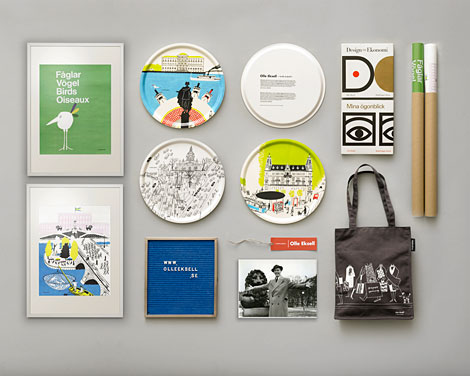
Thanks to Johan Anderson for notifying me of the brand new Olle Eksell tribute site! Included on the website are videos, suggested links, a timeline, as well as rare photos of Olle with his wife and peers. In addition, Johan worked with the Eksell family to release a small collection of products which feature Olle’s stunning illustration work.
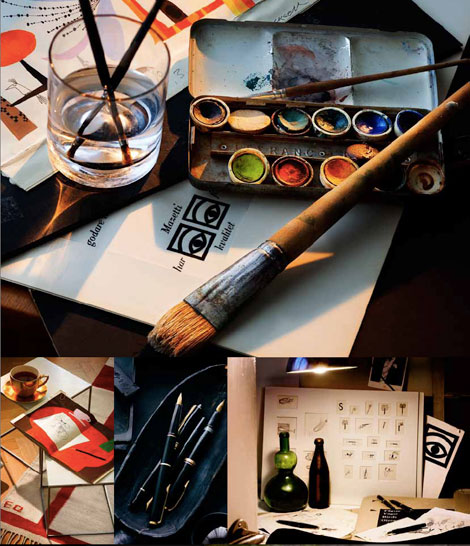
photo credit: Bruno Ehrs
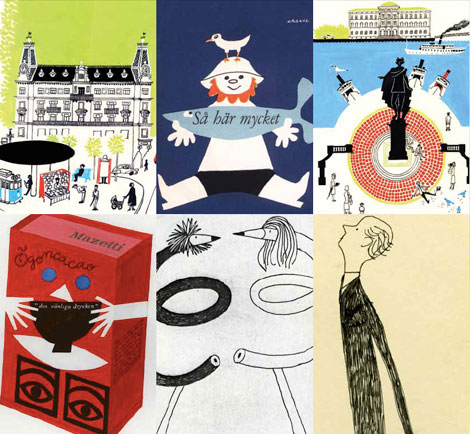

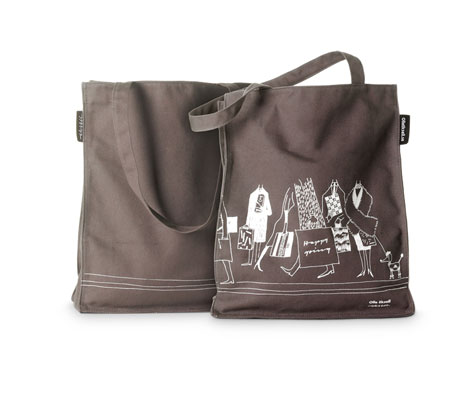
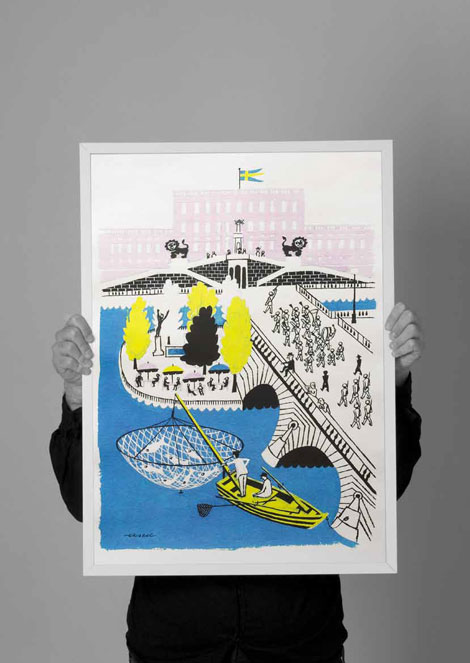
More images +info are available at the Olle Eksell shop.
Catch Olle on Facebook as well.
——————–
Also worth viewing:
Alvin Lustig
Alexander Girard Book
Karel Martens: Printed Matter
Not signed up for the Grain Edit RSS Feed yet? Give it a try. Its free and yummy.
——————–
Share This
Grain Edit recommends: Saul Bass - Henri's Walk to Paris. Check it out here.
©2012 Grain Edit - catch us on Facebook and twitter
.jpeg?picon=3306)
By: Zoe,
on 2/8/2012
Blog:
Playing by the book
(
Login to Add to MyJacketFlap)
JacketFlap tags:
Houses,
Hats,
Fire,
Building,
Sweden,
Books in translation,
Islands,
Elsa Beskow,
Moving House,
Behaviour (good or bad),
Add a tag
 My girls are going through a phase where what they most want to do pretty much all of the time is create miniature landscapes, with building bricks, playmobil, sylvanian family furniture and animals, supplemented by all sorts of knick-knacks that little children have a magical ability to accumulate. These “set-ups” as the girls call them are often inspired by the books we’re reading, and the latest book to be given the landscape makeover is The Children of Hat Cottage by Elsa Beskow.
My girls are going through a phase where what they most want to do pretty much all of the time is create miniature landscapes, with building bricks, playmobil, sylvanian family furniture and animals, supplemented by all sorts of knick-knacks that little children have a magical ability to accumulate. These “set-ups” as the girls call them are often inspired by the books we’re reading, and the latest book to be given the landscape makeover is The Children of Hat Cottage by Elsa Beskow.
In a nutshell, The Children of Hat Cottage tells the sort of tale many parents will recognise – about children trying to be helpful, but ending up making a bigger mess than there was before.
A mother lives with her three young children in a cottage shaped like a hat. One day she has to leave them at home whilst she goes off to buy yarn to make new clothes (isn’t it liberating and exciting how in fairytale-like stories, it’s perfectly possible to leave children at home alone!). Whilst their mother is away the children decide to do something nice for her; they clean the cottage chimney. But one thing leads to another and disaster strikes… their beautiful little hat home burns down.

Fortunately there is a friendly neighbour who comes to the aid of the children, and together they work to save the day. The mother returns, and though initially shocked, everyone shows great composure, makes the best of the situation and out of hard times, lots of love (and a new home) flourishes.
This is a sweet little story with simple, but lovely illustrations. The themes of independence, triumphing over adversity, and keep one’s cool in the face of disaster are great for shared storytime. The fairytale aspects of the setting will delight children who want to believe in gnomes and little spirits, and the poise with which the mother picks up the remains of her burnt-out life and makes the best of it is something I shall aspire to when things are higgledey-piggeldy in my life.
There’s plenty to like about this story, but hand on heart, I don’t believe this is one of Elsa Beskow’s greatest books. The illustrations are somewhat sparse compared to some of her work. They are quick, fluid sketches rather than the detailed images you find in, for example, Around the Year or Children of the Forest. Still, we’ve enjoyed it and it has inspired plenty of play in our family, as I’m sure it will in yours.
Here are some scenes from one of M and J’s “Hat Cottage set-ups”, including a little cottage we made inspired by the one in the illustration above.


 3 Comments on Minature landscapes and giant hats, last added: 2/8/2012
3 Comments on Minature landscapes and giant hats, last added: 2/8/2012
 I’ll start today with an admission.
I’ll start today with an admission.
We don’t really “do” Christmas in our home.
It’s not that we go out of our way to avoid it, but it’s not a celebration we wait all year for. M’s birthday is just before the 25th, we’re not a religious family, and we don’t want to be sucked in to a big cycle of (over) consumption, so all in all, Christmas is a quiet time for us. We don’t do stockings, we don’t have faith, but (of course) we can’t entirely do without books.
Findus at Christmas by Sven Nordqvist is one of the few Christmassy books that we have already enjoyed and will no doubt read ever more frequently in the coming weeks. We’re huge fans of eccentric old farmer Pettson and his cheeky cat Findus (for my reviews of earlier Pettson and Findus books click here), and in this story there’s everything we could hope for.
It’s December 23rd and after days of terribly wintry weather, finally Pettson and Findus can set about getting everything ready for Christmas Day. They’ve got so much to do; shopping, baking, felling the Christmas tree and preparing the house. But disaster strikes when out in the forest they have a sledging accident and Pettson badly hurts his foot.
Having limped back home it becomes clear that Christmas isn’t going to happen as they’d planned. They’ve almost no food in the larder and the house is bare of decoration. “Silently they sat and watched their reflection in the window against the darkness outside. It can get this quiet when things don’t turn out the way you expect.”
Christmas morning arrives and a neighbour pops his head round the door to check everything is ok. When he sees the state of Pettson’s foot, and hears Findus’ wailing he steps into the breach and brings in some firewood and promises to return later with milk.

As word spreads of Pettson’s predicament, one by one neighbours rally round, each bringing a basket of delicious food. Pettson and Findus have managed to make a Christmas tree laden with imaginative decorations out of a bits and bobs they have lying around and unexpectedly the house is full of ““Merry Christmas!” and talk and laughter” as neighbours and their families stay and share good will and good cheer. Christmas turns out to be better then the farmer and his cat could have possibly hoped for.
This story is my sort of Christmas story: what really matters about this season, is not the tree, is not the rushing around like crazy trying to do too many things, but rather simply generosity, kindness and community.
The “message” shines through in a gentle but powerful way because the book is packed with humour, both verbal and pictorial. The capers Pettson and Findus get up to, from surfing over the wet floor of the kitchen, to choosing unusual Christmas presents for each other will get you giggling, whilst the affection that is so strong between the farmer and his feline friend will make you feel like hugging those near and dear to you. A pretty good way to start Christmas, don’t you think?

3 Comments on
(Sort of) Counting down the days till Christmas, last added: 11/15/2011

Stockholm Design Lab is a Sweden-based laboratory of sorts. As a firm they have their hands in just about everything — design, architecture, product development, video, interiors, and more. Although, a core tenant of their philosophy is not to differentiate between these fields. It appears obvious from their work, and successful.
The overall feel and quality of SDL’s work feel consistent in quality of application, but more process driven in terms of style. The Scandinavian influence is definitely apparent, but overall I like how each project feels individual and fine-tuned.
Check them out!
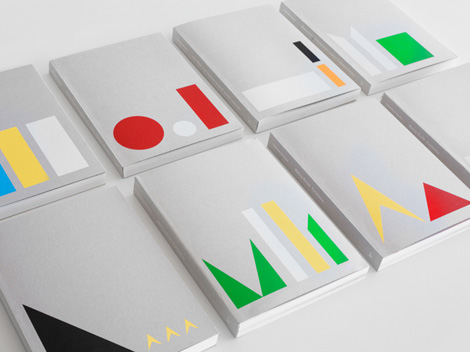

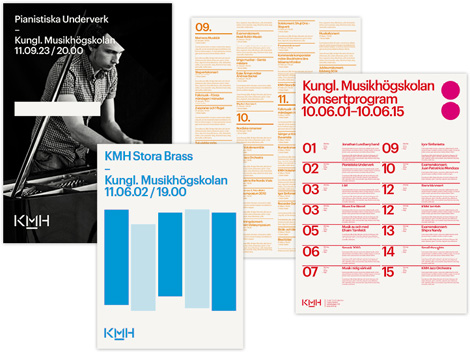



——————–
Also worth viewing:
Timba Smits
Herb Lubalin Archives
Mike Davis Interview
Not signed up for the Grain Edit RSS Feed yet? Give it a try. Its free and yummy.
——————–
No Tags
Share This
Congrats to our winners in the Bike Print giveaway: Gianluigi Farnetti, Brian_HF, brianjbarron, Adrienne Wu
Grain Edit recommends: Karel Martens: Printed Matter. Check it out here.
©2009 Grain Edit - catch us on Facebook and twitter

By: Jerry Beck,
on 9/28/2011
Blog:
Cartoon Brew
(
Login to Add to MyJacketFlap)
JacketFlap tags:
Laurent Clermont,
Animated Fragments,
Anthony Schepperd,
Denis Borisovich,
Fiorella Pierini,
Hajime Nagatsuka,
US,
Japan,
UK,
Russia,
Sweden,
Add a tag
Maria Curman is to leave her post as chief executive of Swedish publisher Bonnier Books at the end of 2011 after 10 years.
read more

By: Laura,
on 8/25/2011
Blog:
the pageturn
(
Login to Add to MyJacketFlap)
JacketFlap tags:
teens,
Libraries,
Books,
travel,
gaming,
YA Books,
library visits,
Sweden,
Europe,
Anna Godbersen,
The Luxe,
guest post,
library design,
Reading Rants,
Jennifer Hubert Swan,
Gothenburg,
Gothenburg Public Library,
teen rooms,
Add a tag
Hi Pageturn readers,
Just like most professional book pushers, whenever I travel to a new locale, the first place I visit is the public library. For most librarians, it’s almost like a homing device: “Must. See. Stacks.” So when my husband and I visited relatives in Gothenburg, Sweden this summer, I made a beeline straight to the Gothenburg Public Library. And I’m so glad I did, because it was an absolute inspiration to see the dazzling space allotted to kids and teens. Here I am in the entrance to the youth area. I was seriously digging that cool blue dragon sign. Unfortunately, they wouldn’t let me bring it home with me. Shoot. It would have looked so good in our picture book room!
It was also very fun to get to see some of my favorite titles in Swedish. I got such a kick out of seeing “The Deluxe” series on the shelves in the youth area. Apparently the title gets an extra syllable in Swedish!
But the piece de resistance had to be the teen room downstairs. Filled with cozy couches, colorful paperbacks (including many adult titles) and entire wall of gaming devices and screens, this was a teenage dream that even Katy Perry would approve of. The full wall of windows opened out into a pretty green courtyard, where teens could go to mingle or chat on their cells.
Here’s the stage (for open mic events) and gaming area. Teens can check out gaming consoles and devices for use in the teen area just
like books. I was super impressed with how much room was provided for teens for digital recreation, a clear indication that this library values their teen patrons and understands their importance to the library’s future success. During a time when public library, and especially teen services, are being cut all over the United States, it was both thrilling and sad to see such a wonderful space being offered to teens that was so respectful of their needs and sensibilities.
On a practical note, I was also geeked out by the beautifully designed library shelving carts. “Gorgeous” isn’t usually a word you use
to describe a book truck, but doesn’t it fit this one perfectly? This is one of the ways you know you are a born librarian—when you get wistful over well-designed library accessories.
View Next 21 Posts






 The idea about helping people share their stories across languages and cultures is still swirling in my head, so I can’t resist asking Nathan about Swedish children’s books which haven’t yet been translated into English but which he thinks would bring joy and delight to new readers. “Barbro Lindgren’s books about Loranga, Masarin och Dartanjang: a young boy, his gleefully irresponsible father and a grandfather who lives in the woodshed. First published in 1969-70, the stories are based — give or take the occasional bed-eating giraffe — on Lindgren’s own experiences raising her young family. They are quite unlike anything I have read before. English readers might recognize in Loranga the very opposite of the helicopter parent. With their surreal humour, the books are perfect for reading aloud — to children and grown-ups alike.”
The idea about helping people share their stories across languages and cultures is still swirling in my head, so I can’t resist asking Nathan about Swedish children’s books which haven’t yet been translated into English but which he thinks would bring joy and delight to new readers. “Barbro Lindgren’s books about Loranga, Masarin och Dartanjang: a young boy, his gleefully irresponsible father and a grandfather who lives in the woodshed. First published in 1969-70, the stories are based — give or take the occasional bed-eating giraffe — on Lindgren’s own experiences raising her young family. They are quite unlike anything I have read before. English readers might recognize in Loranga the very opposite of the helicopter parent. With their surreal humour, the books are perfect for reading aloud — to children and grown-ups alike.”
 And so when I opened
And so when I opened 






 This forward and full-of-hope looking at the future, with plans for play and learning, is also found in the latest offering (in English) for fans of two of my very favourite book characters:
This forward and full-of-hope looking at the future, with plans for play and learning, is also found in the latest offering (in English) for fans of two of my very favourite book characters: 








 course it’s important to be aware of injustice, but it sends a powerful message if we only show racial diversity in settings of suffering and conflict.
course it’s important to be aware of injustice, but it sends a powerful message if we only show racial diversity in settings of suffering and conflict.

 around racial stereotypes through her fascinating
around racial stereotypes through her fascinating 
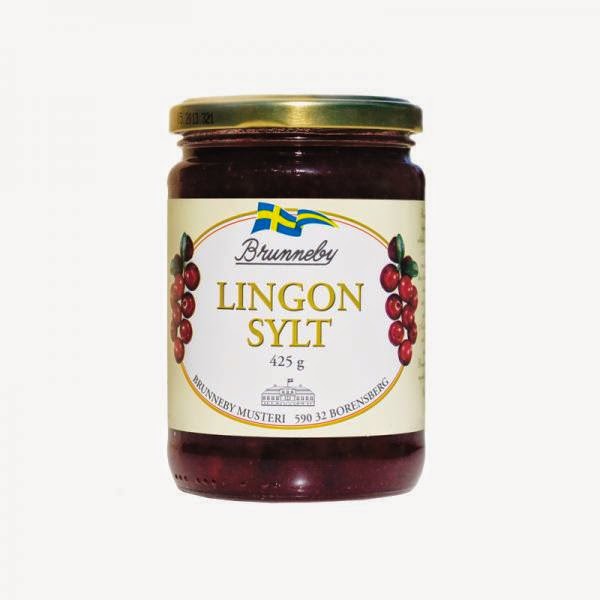



























 3 Comments on Minature landscapes and giant hats, last added: 2/8/2012
3 Comments on Minature landscapes and giant hats, last added: 2/8/2012














Thank you for this interview! Great picture book translation conversation!
I love this! Thanks especially for your observation that “translators really are authors in disguise; translators, particularly literary translators, have to be great writers in their own language before sensitivity to a second language can come in to it.” Hear, hear. I am excited to read Findus Goes Fishing in Nathan Large’s rendering.
Such a delight to see the Scandanavian books translated! We have “A rumpus in the garden” By Sven Nordqvist. Such fun to look at all the pictures, there is so much happening, you see more every time you look. Also great to see an interview with a translator and see their perspective and insights.